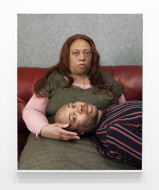JTF (just the facts): A total of 6 large scale color photographs, framed in white and unmatted, and hung against white walls in the main gallery space, the entry area, and the office. All of the works are pigment prints, made in 2018 or 2019. Physical sizes range from roughly 45×30 to 50×40 inches, and the prints are available in editions of 6.
Comments/Context: D’Angelo Lovell Williams’ accomplished new show cements his position as a talented young photographer on the rise.
His first show at Higher Pictures (in 2017, reviewed here) introduced us to a voice thoughtfully exploring the contours of black masculinity in the 21st century. A selection of intimate self-portraits, it sensitively worked to redefine the relationship between blackness and queerness, consciously carving out room for himself within the broader dialogue of personal identity and inside the history of photography.
Building on that success, this show extends his subject matter beyond the strict confines of himself, exploring his connections to family, friends, and lovers, and the particular nuances found in those relationships given who he is. At this early stage of his career, we should expect to see him experimenting, trying to figure things out, and these pictures simmer with new risks. But the fact that this exhibit only includes six photographs, out of the presumably many more he has been making over the past two years, says something about the maturity of his vision – this group is extremely tightly edited, honed to a kind of delicate sharpness, with no filler or fat. The result is a show that feels both controlled and expansive, one that expands his artistic footprint with precision and care.
The formality of Williams’ compositions signals that everything we see has been placed there with intention, giving the pictures a coded feel. And while like many, I can pick out obvious art historical and cultural allusions, the pictures remind me that as a viewer, I am coming from a very different personal reality and so I may not be able to decipher all of Williams’ influences and references (I have this same feeling with Deana Lawson’s work). On one hand, this confirms my position a step outside of the artist’s own world; on the other, it makes me want to fill in my own personal blind spots so I can appreciate all the richness the photographs have to offer.
Williams’ photograph with his mother is the most striking in the show. She cradles the head of her adult son in her lap in the mode of a classic Madonna and child religious painting, their mouths perplexingly connected by a strand of red chewing gum. The tenderness (and ultimate fragility) of their connection is made clear by the visual metaphor, the gum extending from one mouth to the other like an umbilical cord. The mother’s wide-eyed stare gives the picture a jolt of surreal power, his gentleness supported and protected by her steely determination.
Other images consider relationships with male friends (and lovers), each pose or interaction layered with meaning. In I’ll Be Up There in a Minute, a young man sits in a tree, his face reduced to one penetrating eye by the surrounding leaves and his legs dangling from above like a lynching. In A Day Apart, Williams hides underneath a lacy white dress worn by his friend, their almost-from-birth connection made physical by the joining effect of the dress and the appearance of the pregnancy bump. Williams gets two friends to join him on a platform for Love Train, their synchronized arm motions mimicking the train motif, while alluding to dance steps of classic R&B trios like the O’Jays, the typical matching suits of those groups replaced here by gender-bending sparkly tops and nylons.
Williams increases the intimacy further in the last two pictures. In Burn One, he dramatically pulls at a friend’s eye with his fingers, a burning cigarette hovering just near enough to make anyone squeamish. Reflected in a mirror below, the image recalls the surreal eye cutting scene in Luis Buñuel’s Un Chien Andalou while also testing the limits of the trust between the two. (The image also brings back the eye theme that runs through many of the pictures in the show.) Hieroglyph 1 finds Williams and a nude partner pulled into a joint back bend figure, the shape reminiscent of the Egyptian ankh. The image itself feels like jujitsu move on the classical forms of Robert Mapplethorpe, flipping the black body as object around into an exercise in active participation and shared experience.
Step by step, Williams is building some intriguing artistic momentum. He has successfully bridged beyond self-examination, now tracing the finely tuned ripples of his own life in those of others.

